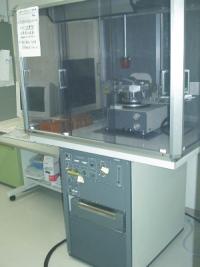Special Program for International Students
GRADUATE COURSE IN EARTH SCIENCE
& GEOENVIRONMENTAL SCIENCE
Facilities

XRD
X-ray Diffraction
Automated X-ray Powder Diffractometer (Rigaku RINT-2000 system)
X-ray powder diffraction (XRD) is a standard but very important tool for identification and characterization of minerals and other crystalline materials. XRD essentially uses monochromatic X-ray radiation to examine finely powdered samples. By using this method, very fine grained natural minerals and synthetic samples can be identified and their unit-cell parameters can be determined. Identification of such phases is of great value in many branches of Geoscience.
Until recently, most structural studies of crystalline materials were based on single crystal X-ray techniques and neutron diffraction analysis. However, in the past decade rapid developments in XRD methodology have made refined crystal structure studies possible using X-ray powder diffraction patterns. This technique is known as the Rietveld method. It allows us to determine the crystal structures of the many minerals that are typically finely crystalline and do not occur as single, well-developed crystals. Prof. Akasaka and his students have successfully studied the crystal structures of both natural and synthetic minerals using Rietveld methodology.
Cold seal pressure vessels for hydrothermal syntheses of minerals
Hydrothermal syntheses of minerals are carried out to investigate phase relations of minerals, and to make pure minerals for studies of their crystal structure and crystal chemistry. The equipment housed in the Dept. of Geoscience allows experiments to be carried out up to maximum pressures and temperatures of 400 MPa and 550°C, respectively. These facilities have and are being used to synthesize okhotskite and pumpellyite-(Mn2+), Ca- and Sr-piemontites, epidote, and several Mn-bearing minerals, and to examine their phase relations.
